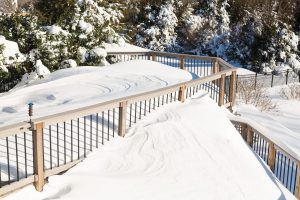 Here in the Midwest, winter weather is no joke. From freezing temperatures to heavy snow and ice, our decks will go through a lot over the next few months. Unfortunately, deck materials can show some damage. Wooden decks can absorb moisture which will be displayed in the look of the planks and in the structural integrity of the wood itself. Meanwhile, composite decking won’t acquire damage from the snow but instead from harsh shoveling. Regardless of which decking material you have, winter deck damage is always a concern. It can be costly, unsightly, and unsafe in some cases as well.
Here in the Midwest, winter weather is no joke. From freezing temperatures to heavy snow and ice, our decks will go through a lot over the next few months. Unfortunately, deck materials can show some damage. Wooden decks can absorb moisture which will be displayed in the look of the planks and in the structural integrity of the wood itself. Meanwhile, composite decking won’t acquire damage from the snow but instead from harsh shoveling. Regardless of which decking material you have, winter deck damage is always a concern. It can be costly, unsightly, and unsafe in some cases as well.
Here at Miles Bradley, we recognize how daunting maintaining a deck in the winter can be. From snow damage to scratches on the material and everything in between. Whether you need deck repairs or a full custom build this winter, fill out our free quote form to find out how we can help you! Just contact us today and get the process started.
There are two main types of decking that we specialize in; wooden and composite. Both of these decking materials face different issues concerning winter deck damage.
Wooden decks are usually more prone to damage in inclement weather due to most wood not being waterproof. This allows the material to absorb moisture from the snow. While this doesn’t typically affect the wood in the short term, besides increasing the risk of slipping on ice, it certainly can cause damage in the long run. Over time, the excess moisture collected in wood can compromise both the look and integrity of the deck itself. This can be avoided by using a proper sealant on wood to make the material waterproof which will help the look and strength of the deck last longer. Shoveling the deck and making sure to reduce exposure time to moisture will also help during periods of heavy snow.
Low-maintenance composite decking protects decks from snow damage during the winter. The composite material is waterproof which prevents moisture from seeping through and in turn, allows the deck to last in its initial condition for long periods. The issue of composite decking in the winter comes from its risk of obtaining scratches and cracks due to excessive wear and tear. To prevent this, consider winterizing your deck and using rubber shovels instead of metal when shoveling snow or ice off.

During the winter, it is important to know how to keep ice off your deck. While people are always scraping ice off their cars and shoveling snow, your deck is facing possible damage. Unlike those items, decks can incur damage if you are not prepared. After all, it takes a strategy to fend off Mother Nature. While decks are built to withstand the weight. So, what methods can you use to protect your deck from winter woes? How should you maintain your winter deck?
One of the best to remove a light snowfall on your deck is using a broom. It is important to avoid scraping against the deck harshly. After all, you can cause damage to your deck if you are harsh. A broom’s soft bristles will prevent scrapes and damage to your deck. However, it will not be ideal when it comes to heavy snow.
Softwood decks like redwood or cedar are vulnerable to scratches and damage. While composite decks have more resistance, they are not immune to scratches and damage either. That is why the type of shovel you use is important. When dealing with snow/ice, you should not use a metal shovel on your deck. Metal shovels and sharp tools can cause significant damage to your deck. Instead, you should use a plastic, rubber-blade shovel. The shovel is gentler on your deck surface compared to other shovels. Although all shovels can scratch your deck, plastic shovels will reduce those chances.
An important tip for shoveling snow and ice off your deck is the way you do it. When shoveling, you should go with the grain of the wood. This will reduce the chances of scratches and damage from shoveling.
It is important to reduce snow weight from your deck. After all, the buildup can cause stress on your deck. Yet, there is a benefit for leaving a few inches of snow behind. This layer of snow can protect your deck from damage or scratches. As stated above, all shovels can scratch your deck. When you shovel extra snow, this layer will prevent the shovel from contacting the deck.
Salt is one of the best ways to get rid of ice. Salt is able to lower the freezing point of water, causing ice to thaw. In fact, road salt is able to reduce ice-related accidents by 85%. While there are some downsides to salt, it is effective. However, you should never use salt on your deck. Salt is has a chemical composition of sodium chloride or calcium chloride. As a result, it can corrode nails, screws, and joints. In addition, salt can dry out the deck’s woods. This can lead to increase chances of damage.
So, what are some other things to avoid? Salt is absolute no. However, there are plenty of other methods and materials that you should avoid using. First of all, you should not use any products that can grind against the deck. This includes salt substitutes like salt, gravel, and rocks. Just like salt, it can damage your deck. However, it impacts the surface instead of the components of the deck. Another thing you should not use to remove ice from your deck is a colorant. These dyes can be fun for kids to play with, especially in the snow. However, never use colorant on your deck. This dye can stain your wood and composite material, even though the snow and ice.
There are always ways to protect your deck in the winter. In fact, you can protect yourself before the winter season starts. Worried about deck right now? Contact us with your questions today!